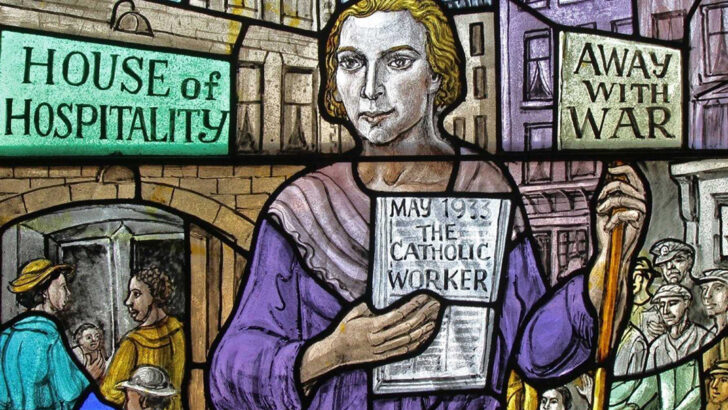We Are Saved Only Together. Living in the Revolutionary Vision of Dorothy Day and the Catholic Worker Movement
by Colin Miller, foreword by Seth Haines (Ave Maria Press, €19.50 / £16.30 / US $ 17.95)
The parable of the Good Samaritan is surely the best known of Jesus’ parables. It is among the most easily understood: our neighbour is all mankind, regardless of our position, we should attend to their needs. It is a humanitarian manifesto whose appeal is heard by believer and unbeliever alike.
This, however, as Miller reminds us, is not how the early Fathers of the Church understood it. Augustine tells us that Jesus is the Good Samaritan and the wounded wretch lying in the ditch stands for us. Wounded by sin, we are brought to health by Jesus. In the inn we await his second coming.
Not then a call to be good to the unfortunate, but a reminder of our fallen state, our need for salvation that is to be found in following Christ. And where do we find Christ? Nothing could be more straightforward: ‘when you did it to the least of these, you did it for me’.
As a young lad, I joined the youth conference of the Society of Saint Vincent de Paul based in my school. As we cycled down, on my first visitation, to the tenement on James Street East, now demolished to make way for the Bank of Ireland on lower Baggot street, the older brother said to me ‘remember in visiting and seeking to help Mrs D, you are encountering Christ.’
Overwhelmed
Visiting the web page of the SVP, I found the message muted, overwhelmed by the undoubtedly fine humanitarian work of the Society. Anyhow it made a deep impression on me, an impression that came back to me as I read this marvelous book.
Miller tells us of what he learnt on his path to follow Christ in the service of the poor. His journey started with the homeless he met close to his Church, when he was a student studying for PhD in theology and then as an Episcopalian priest.
His guides were Dorothy Day and Peter Maurin and the Catholic Worker Movement they inspired.
He brings the lessons he learnt alive in clear prose and vivid details that manifest profound truths. He co-founded a Catholic Worker House of Hospitality in Durham, North Carolina. Now a Catholic and director of the centre for Catholic social thought at the Church of the Assumption, St Paul’s Minnesota, he lives in a House of Hospitality with his family.
Dorothy Day (1897-1980), a bohemian who moved in literary circles while active in socialist and anarchist movements, converted to Catholicism in 1928. Her keen awareness of the injustices of this world remained, and the question as to what, as a Catholic, she should do troubled her.
He had the theory, she had the determination and strength to put it into practice, together they inspired communities that gave and continue to give powerful witness”
She prayed and her prayer was answered when Peter Maurin (1877-1949) arrived at her door. Maurin, from a poor French farming background, who served briefly as a De La Salle brother, was well versed in the Catholic tradition, its theology, philosophy and especially its social teaching. He led a hand-to-mouth existence, tutoring in French, working as a labourer and telling anyone who would listen how the Gospel would set them free.
He had the theory, she had the determination and strength to put it into practice, together they inspired communities that gave and continue to give powerful witness.
These communities are models, or fractals, of what the Church is called to be: committed to helping the poor, not only with handouts but in community, sharing their lives as we eat and worship together; studying the tradition of the Church, making its teachings relevant to a changing world; showing the world that the promise of a social order free from the abuses of power, exploitation, the fragmentation, the loneliness, the work that drains and does not fulfill, is not vain.
Dimension
Going to Mass had once both a social and a spiritual dimension. You were Irish and Catholic and that is what you did, dressed in your best. Not to attend, to decide to step apart was to be eccentric; it was easier by far to conform to the conventions of your social circle. The social pressure has gone into reverse. To attend is now, especially for the young, the eccentric choice. The social dimension has disappeared.
Regular attendance at the gym keeps the muscles strong and supple; that it hardly benefits society, or anybody else, is not a problem. A question that bothers me: is my attendance at Mass any better than a visit to a spiritual ‘gym’? Surely it should be more?
The readings instruct us in the kingdom of God that the Eucharist, prefigures making it a real presence amongst us. As we pray the Pater Noster we are reminded of the gap between the world and the Kingdom. We are strengthened to resist the lures, the sins of the world. It is one thing to be told to mind the gap, another to work to close it.
Surely, our celebration of the Eucharist is incomplete if it does not bring us, however inadequately, together to work to bring the Kingdom closer? We need to build community and recover a social dimension. How to do this?
We Are Only Saved Together is a good guide and an inspiration. All will benefit from reading it, especially those on pastoral councils or engaged in the synodal processes.


 A stained glass image of Dorothy Day
A stained glass image of Dorothy Day